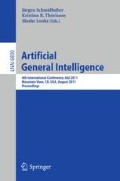Abstract
Can research into artificial general intelligence actually benefit from neuroscience and vice-versa? Many AGI researchers are interested in the human mind. Within reasonable limits, we can posit that the human mind is a working general intelligence. There is also a strong connection between work on human enhancement and AGI. Here, we note that there are serious limitations to the use of cognitive models as inspiration for the components deemed necessary to produce general intelligence. A closer examination of the neuroscience may reveal missing functions and hidden interactions. This is possible by making explicit the map of brain circuitry at a scope and a resolution that is required to emulate brain functions.
Access this chapter
Tax calculation will be finalised at checkout
Purchases are for personal use only
Preview
Unable to display preview. Download preview PDF.
References
Goertzel, B., Pennachin, C.: Artificial General Intelligence. Springer, New York (2007)
Markram, H.: The Blue Brain Project. Nature Reviews Neuroscience 7, 153–160 (2006)
Hutter, M.: Universal Artificial Intelligence: Sequential Decisions based on Algorithmic Probability. Springer, Berlin (2004)
Wang, P.: Artificial General Intelligence: A Gentle Introduction, http://sites.google.com/site/narswang/home/agi-introduction
Gildert, S.: Pavlov’s AI: What do superintelligences REALLY want? At: Humanity+ @Caltech, Pasadena, CA (2010)
Luger, G.F.: Artificial Intelligence: Structures and Strategies for Complex Problem Solving, 6th edn. Addison-Wesley, New York (2008)
Burns, N.R., Lee, M.D., Vickers, D.: Individual Differences in Problem Solving and Intelligence. Journal of Problem Solving (2006)
Anderson, J.R., Bothell, D., Byrne, M.D., Douglass, S., Lebiere, C., Qin, Y.: An integrated theory of the mind. Psychological Review, 1036–1060 (2004)
Laird, J., Newell, A., Rosenbloom, P.: SOAR: an architecture for general intelligence. Journal of Artificial Intelligence 33(1), 1–63 (1987)
Lehman, J.F., Laird, J., Rosenbloom, P.: A Gentle Introduction to SOAR: An Architecture for Human Cognition: 2006 Update (2006)
Sutton, R.S., Barto, A.G.: Reinforcement Learning: An Introduction. MIT Press, Cambridge (1998)
Marr, D., Ullman, S., Poggio, T.: Vision. In: A Computational Investigation into the Human Representation and Processing of Visual Information. MIT Press, Cambridge (2010)
Hubel, D.H., Wiesel, T.N.: Receptive fields, binocular interaction and functional architecture in the cat’s visual cortex. Journal of Physiology 160, 106–154 (1962)
Op de Beek, H.P., Haushofer, J., Kanwisher, N.G.: Interpreting fMRI data: maps, modules and dimensions. Nature Reviews Neuroscience 9, 123–135 (2008)
Geissler, H.-G., Link, S.W., Townsend, J.T. (eds.): Cognition, Information Processing, and Psychophysics: Basic Issues, Erlbaum, Hillsdale, NJ (1992)
Saltelli, A., Tarantola, S., Chan, K.: Quantitative model-independent method for global sensitivity analysis of model output. Technometrics 41(1), 39–56 (1999)
Winsberg, E.: Simulations, models and theories: Complex physical systems and their representations. Philosophy of Science 68(3); Supplement: Proceedings of the 2000 Biennial Meeting of the Philosophy of Science Association. Part I: Contributed Papers (September 2001), pp. S442-S454 (2000)
Sporns, O., Tononi, G., Kötter, R.: The Human Connectome: A Structural Description of the Human Brain. PloS Computational Biology 1(4), e42 (2005)
Hassabis, D.: Combining systems neuroscience and machine learning: a new approach to AGI. At: The Singularity Summit 2010, San Francisco, CA (2010)
Koene, R.A.: The 25 Watt bio-computer: Lessons for Artificial Human Intelligence and Substrate-Independent Minds. At: Humanity+ @Caltech, Pasadena, CA (2010)
Koene, R.A.: Functional requirements determine relevant ingredients to model for on-line acquisition of context dependent memory. Ph.D. Dissertation, McGill University, Montreal, Canada (2001)
Koene, R.A., Hasselmo, M.E.: First-in-first-out item replacement in a model of short-term memory based on persistent spiking. Cerebral Cortex 17(8), 1766–1781 (2007)
Koene, R.A., Hasselmo, M.E.: Reversed and forward buffering of behavioral spike sequences enables retrospective and prospective retrieval in hippocampal regions CA3 and CA1. Neural Networks 21(2-3), 276–288 (2008)
Gorelik, D.: Reducing AGI complexity: copy only high level brain design, http://aidevelopment.blogspot.com/2007/12/reducing-agi-complexity-copy-only-high.html
Fodor, J.: The Mind Doesn’t Work That Way: The Scope and Limits of Computational Psychology. MIT Press, Cambridge (2000)
Strong AI, Wikipedia, http://en.wikipedia.org/wiki/Strong_AI#Whole_brain_emulation
AI is NOT part of transhumanism, Human Enhancement and Biopolitics, http://hplusbiopolitics.wordpress.com/2008/06/13/ai-is-not-part-of-transhumanism/
Author information
Authors and Affiliations
Editor information
Editors and Affiliations
Rights and permissions
Copyright information
© 2011 Springer-Verlag Berlin Heidelberg
About this paper
Cite this paper
Koene, R.A. (2011). AGI and Neuroscience: Open Sourcing the Brain. In: Schmidhuber, J., Thórisson, K.R., Looks, M. (eds) Artificial General Intelligence. AGI 2011. Lecture Notes in Computer Science(), vol 6830. Springer, Berlin, Heidelberg. https://doi.org/10.1007/978-3-642-22887-2_50
Download citation
DOI: https://doi.org/10.1007/978-3-642-22887-2_50
Publisher Name: Springer, Berlin, Heidelberg
Print ISBN: 978-3-642-22886-5
Online ISBN: 978-3-642-22887-2
eBook Packages: Computer ScienceComputer Science (R0)

